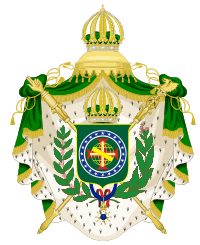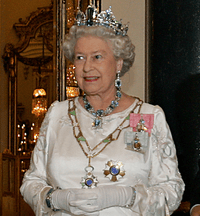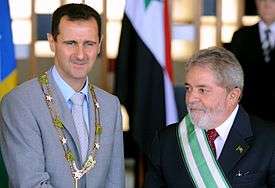Order of the Southern Cross
| National Order of the Southern Cross | |
|---|---|
 | |
| Grand Collar of the National Order of the Southern Cross | |
| Awarded by the Government of Brazil | |
| Type | Order |
| Motto | Benemerentium Premium[1] |
| Eligibility | Foreign nationals[2] |
| Awarded for | "As a token of gratitude and recognition for those who have rendered significant service to the Brazilian nation."[2] |
| Status | Currently awarded |
| Grand Master | His Excellency the President of Brazil[3] |
| Chancellor | His Excellency the Minister of Foreign Affairs[3] |
| Grades (w/ post-nominals) | Grand Collar[4] Grand Cross[4] Grand Officer[4] Commander[4] Officer[4] Knight[4] |
| Established | 1822–1891 (imperial order) 1932– (current order) |
| First induction | December 1, 1822[5] |
| | |
| Ribbon bar of the National Order of the Southern Cross | |
The National Order of the Southern Cross (Portuguese: Ordem Nacional do Cruzeiro do Sul) is a Brazilian order of chivalry founded by Emperor Pedro I on 1 December 1822. This order was intended to commemorate the independence of Brazil and the coronation of Pedro I.[6] The name derives from the geographical position of the country, under the constellation of the Southern Cross and also in memory of the name – Terra de Santa Cruz – given to Brazil at the time of European discovery.[5]
History
Originally known as the Imperial Order of the Southern Cross (Ordem Imperial do Cruzeiro do Sul), the Order was created by Emperor Pedro I on the day of his Coronation, 1 December 1822. Also on the same date the first knights of the order were appointed, to commemorate the crowning of the Empire's first monarch. After the proclamation of the independence of Brazil on 7 September 1822 other honorific awards had been made, but of the Orders of chivalry shared with Portugal, Brazilian branches of which had been created upon independence; the Order of the Southern Cross, created to mark the Coronation of the Empire's founder, was thus also the first purely Brazilian Order.
After the fall of the monarchy, Brazil's first republican Constitution, enacted on 24 February 1891, abolished all titles of nobility and all Imperial Orders and decorations.[5] The Order was later re-established by the government of Getúlio Vargas on December 5, 1932, as the National Order of the Southern Cross.[5]

During the Old Republic period (from the Proclamation of the Republic until the Revolution of 1930), National Orders did not exist and the Brazilian State bestowed only military medals.[7] Restored in 1932, the Order of the Southern Cross was the first Order to be created in the re-established, republican honours system. It is considered the senior Brazilian National Order.
During the Imperial period, the Order of the Southern Cross was not the highest ranking of the Imperial Orders, as it ranked below the Brazilian branches of the ancient orders of chivalry, that originated with Portugal: the Order of Christ (the senior-most Order), the Order of Saint Benedict of Aviz and the Order of St. James of the Sword. Those Orders were shared by Brazil and Portugal; the Order of Christ was shared with the Holy See similar to the Austrian and a Spanish Orders of the Golden Fleece. However among the Brazilian created Orders, the Imperial Order of the Southern Cross ranked first, having higher status than the Imperial Order of Pedro I and the Imperial Order of the Rose.
The Imperial Order of the Southern Cross continues to be used by both branches of the Brazilian Imperial Family as a House Order, awarded by the rival claimants to the position of Head of the Imperial Family, but such awards are not recognized by the Republic of Brazil.
Just like the Emperors of Brazil were ex officio Grand Masters of the Imperial Order, Presidents of Brazil are ex officio Grand Masters of the successor National Order. Accordingly, President Dilma Rousseff is the Order's current Grand Master.
Criteria

Unlike the Imperial Order, that was awarded to Brazilians and foreigners alike, the republican National Order is awarded to foreigners only. When the Order was re-established in by presidential decree on January 13, 1932,[8] it was restricted to foreigners only with the stipulation that all awards of the Order constitute an act of foreign relations on the part of the Brazilian Government.[9]

Brazilians were excluded deliberately. In the Old Republic, the State regarded Orders and decorations as contrary to the principles of republicanism, and thus maintained no honours system; the creation of an Order that would admit Brazilians to its ranks was a step too far. However, the Brazilian State also resented the lack of a decoration with which to honour foreign dignitaries, as is sometimes almost required by diplomatic protocol. For instance, during the celebrations of the Centennial of Brazilian Independence in 1922, several foreign dignitaries, including the King and Queen of the Belgians, came to Brazil for the celebrations The King of the Belgians bestowed Belgian honours to some Brazilians. Under normal circumstances, Brazilian nationals needed authorization from the Government to accept foreign titles of honour, or else face loss of citizenship. While the government of Brazil relaxed its practice and authorized both accepting foreign honours and the wearing of foreign insignia, it lacked any decorations with which to reciprocate the Belgian gesture. The National Order of the Southern Cross was intended as an Order that would fill that gap. Today, accepting foreign honours and insignia is allowed, and several order have been established to which Brazilians may be admitted, including the National Order of Merit (Ordem Nacional do Mérito), created in 1946. Even so, the governing statutes of the National Order of the Southern Cross have never been reformed, and thus remains unavailable to Brazilians. Paradoxically, therefore, the Order's Grand Master -- the sitting President of the Republic -- is never a member of the order he or she oversees.
The Decree that re-created the Order (Decree 22.165, signed by Vargas on 5 December 1932) does not mention the creation of a new Order, but the reestablishment of the old Order of the Southern Cross, that had been "created upon the advent of the political independence of Brazil". This was done to improve the prestige of the Order by linking it with the past, that is, by associating it with an Order that had been created more than one century earlier.[10]
In 1932, the republican version of the Order had the same five grades as the old imperial version. In 1939, by a statute issued on 17 July of that year, the additional grade of the Grand Collar was created.[11] Until the creation of the Grand Collar, awards of which are restricted to Heads of State, the Grand Cross was the Order's highest rank.
Awards of, and promotions in, the National Order of the Southern Cross are made by decree of the President of the Republic, in his capacity as the Order's Grand Master. The decree of appointment or promotion is, like all presidential decrees, published in the Federal Government's Official Journal, and, as per the Order's regulations, the appointment or promotion is also recorded in a book kept by the Order's secretary.
The Brazilian Minister of Foreign Relations serves as the Chancellor of the Order, and an officer of the Ministry of Foreign Relations that heads the ceremonial and protocol division serves as the Secretary to the Order. The Order also has a Council, chaired by its Chancellor, that recommends awards and promotions.
Classes

Under its current regulations, the Order consists of the Grand Master and six Classes of members:[4]
- Grand Collar: the recipient wears the adorned "Grand Collar", a chain from which the badge of the order is suspended. The recipient is also allowed to combine the wearing of the Grand Collar with any of the following insignia, or with both: the "Star" of the Order (a plaque modelled after the badge of the Order, to be worn on the left breast); and the Sash of the Order, that is proper to those of Grand Cross rank (a light blue sash, to be worn on the right shoulder). Awards of the Grand Collar are restricted to foreign Heads of State.
- Grand Cross: the recipient wears the Sash of the Order, and the badge of the Order hangs from the bottom part of that sash (given that the sash is worn on the right shoulder, the badge hangs close to the left leg, by the waist line). The recipient further wears the "star" of the Order, displayed on the left breast.
- Grand Officer: the recipient wears the badge of the Order around the neck suspended from a blue ribbon necklet, and the star of the order is displayed on the left breast.
- Commander: the recipient wears the badge of the order around the neck, suspended from a blue ribbon necklet.
- Officer: the recipient wears the badge of the Order on left breast suspended from a ribbon with a rosette.
- Knight: the recipient wears the badge of the Order on the left breast suspended from a simple ribbon.
| Ribbon bars | |||||
|---|---|---|---|---|---|
Notable recipients


- 2016 –
 Rosen Plevneliev (President of Bulgaria)[12]
Rosen Plevneliev (President of Bulgaria)[12] - 2015 –
 Cristina Fernández de Kirchner (President of Argentina)[13]
Cristina Fernández de Kirchner (President of Argentina)[13] - 2014 –
 Julio de Vido (Minister of Federal Planning, Services and Public Investment of Argentina)[14]
Julio de Vido (Minister of Federal Planning, Services and Public Investment of Argentina)[14] - 2013 –
 José Antonio Abreu (pianist)[15]
José Antonio Abreu (pianist)[15] - 2011 –
 Georgi Parvanov (President of Bulgaria)[16]
Georgi Parvanov (President of Bulgaria)[16] - 2011 –
 María Ángela Holguín (Minister of Foreign Affairs of Colombia)[17]
María Ángela Holguín (Minister of Foreign Affairs of Colombia)[17] - 2010 –
 Bashar al-Assad (President of Syria)
Bashar al-Assad (President of Syria) - 2009 –
 Nicolas Sarkozy (President of France)[18]
Nicolas Sarkozy (President of France)[18] - 2009 –
 Arturo Valenzuela (Assistant Secretary of State for Western Hemisphere Affairs)[19]
Arturo Valenzuela (Assistant Secretary of State for Western Hemisphere Affairs)[19] - 2007 –
 Carl XVI Gustaf (King of Sweden)[20]
Carl XVI Gustaf (King of Sweden)[20] - 2007 –
 Silvia Sommerlath (Queen consort of Sweden)[20]
Silvia Sommerlath (Queen consort of Sweden)[20] - 2006 –
 Jacques Diouf (diplomat)[21]
Jacques Diouf (diplomat)[21] - 2004 –
 James Sherwood (founder of Venice-Simplon Orient Express)[22]
James Sherwood (founder of Venice-Simplon Orient Express)[22] - 2003 –
 Yasuo Tanaka (governor of Nagano)[23]
Yasuo Tanaka (governor of Nagano)[23] - 2003 –
 Ann Hartness (scholar)[24]
Ann Hartness (scholar)[24] - 1999 –
 Alberto Fujimori (Peruvian president)[25]
Alberto Fujimori (Peruvian president)[25] - 1999 –
 Albert Fishlow (professor)[26]
Albert Fishlow (professor)[26] - 1999 –
 Giovanni Sartori (political scientist)[27]
Giovanni Sartori (political scientist)[27] - 1998 –
 Ricardo Salgado (President and founder of Banco Espírito Santo)[28]
Ricardo Salgado (President and founder of Banco Espírito Santo)[28] - 1996 –
 Stephan Schmidheiny (entrepreneur)[29]
Stephan Schmidheiny (entrepreneur)[29] - 1975 –
.svg.png) Nicolae Ceausescu (Romanian president)[30]]]
Nicolae Ceausescu (Romanian president)[30]]] - 1968 –
 Elizabeth II (Queen of the United Kingdom and of the other Commonwealth Realms)
Elizabeth II (Queen of the United Kingdom and of the other Commonwealth Realms) - 1964 –
 Felix Grant (radio presenter)[31]
Felix Grant (radio presenter)[31] - 1963 –
 Blaže Koneski (President of the Association of Yugoslav Writers)[32]
Blaže Koneski (President of the Association of Yugoslav Writers)[32] - 1963 –
 Ivan Rukavina (Vice-Minister of Defense of Yugoslavia)[32]
Ivan Rukavina (Vice-Minister of Defense of Yugoslavia)[32] - 1963 –
 Josip Broz Tito (as President of Yugoslavia)
Josip Broz Tito (as President of Yugoslavia) - 1961 –
 Che Guevara (revolutionary)[33]
Che Guevara (revolutionary)[33] - 1956 –
 Sukarno (Precursor of Asian-African Conference, President of Indonesia)
Sukarno (Precursor of Asian-African Conference, President of Indonesia) - 1954 –
 Dwight D. Eisenhower (Supreme Commander WWII, President of the United States)
Dwight D. Eisenhower (Supreme Commander WWII, President of the United States) - 1952 –
 Helen Keller (activist)[34]
Helen Keller (activist)[34] - 1944 –
 Ira C. Eaker (general of the United States Army Air Forces)[35]
Ira C. Eaker (general of the United States Army Air Forces)[35] - 1944 –
 Douglas Fairbanks Jr. (Naval officer)
Douglas Fairbanks Jr. (Naval officer) - 1940 –
 Robert B. Williams (pilot)[36]
Robert B. Williams (pilot)[36] - 1935 –
 Jean Batten (aviator)[37]
Jean Batten (aviator)[37]
among others
References
- ↑ Ordem Nacional do Cruzeiro do Sul Banco Central do Brasil. Retrieved on 2010-10-10. (Portuguese).
- 1 2 National Order of the Southern Cross Medal-Medaille. Retrieved on 2010-10-10.
- 1 2 Condecorações: Cruizeiro do Sul – Conselho Ministério das Relações Exteriores. Retrieved on 2010-10-10. (Portuguese).
- 1 2 3 4 5 6 7 Condecorações: Cruizeiro do Sul – Regulamento Ministério das Relações Exteriores. Retrieved on 2010-10-10. (Portuguese).
- 1 2 3 4 Condecorações: Cruizeiro do Sul – Histórico Ministério das Relações Exteriores. Retrieved on 2010-10-10. (Portuguese).
- ↑ White, William. Notes and queries, Volume 78. London: 1888, p. 173.
- ↑ Even the short-lived republican Ordem de Colombo (Order of Columbus) that had been established by the Provisional Government of the Republic as a replacement to the Imperial Orders, was abolished when Congress promulgated Brazil's first republican Constitution on 24 February 1891, declaring all Orders abolished and stating that the Republic would maintain no Orders. Only after the 1891 Constitution had ceased to operate due to the 1930 Revolution was a republican honours system created, beginning with the recreation of the Order of the Southern Cross in 1932.
- ↑ http://www6.senado.gov.br/legislacao/ListaNormas.action?numero=68055&tipo_norma=DEC&data=19710113&link=s
- ↑ http://www2.mre.gov.br/Cerimonial/CruzeirodoSul/Home-CS.htm
- ↑ http://www6.senado.gov.br/legislacao/ListaTextoIntegral.action?id=26254 Decree that "Reestablishes the National Order of the Southern Cross".
- ↑ http://www2.camara.gov.br/legin/fed/declei/1930-1939/decreto-lei-1424-17-julho-1939-411334-publicacaooriginal-1-pe.html
- ↑ Ministério das Relações Exteriores - Decreto de 1º de Fevereiro de 2016. Published by Imprensa Nacional in Section 1 of Diário Oficial da União of February 2, 2016. ISSN 1677-7042.
- ↑ http://www.losandes.com.ar/article/dilma-rousseff-se-emociono-al-condecorar-a-cristina-con-la-orden-del-sur-de-brasil
- ↑ http://www.telam.com.ar/notas/201405/63352-de-vido-argentina-brasil-y-la-region-estan-muchisimo-mejor-que-hace-diez-anos.html
- ↑ http://www.noticias24.com/gente/noticia/98967/el-maestro-abreu-fue-galardonado-con-la-orden-nacional-cruzeiro-do-sul-por-dilma-rousseff/
- ↑ Presidente Dilma é condecorada com a mais alta ordem da Bulgária GazetaOnline. Retrieved on 2011-10-05. (Portuguese).
- ↑ http://memoria.ebc.com.br/agenciabrasil/noticia/2011-10-26/brasil-e-colombia-assinam-acordos-para-intensificar-relacoes
- ↑ http://g1.globo.com/Noticias/Mundo/0,,MUL1293839-5602,00.html
- ↑ http://www.state.gov/r/pa/prs/ps/2009/nov/131790.htm
- 1 2 https://www.anpfoto.nl/search.pp?page=1&ShowPicture=6280020&pos=6
- ↑ "Dr Jacques Diouf, Director-General Food and Agriculture Organization of the United Nations (FAO)". FAO website. Food and Agriculture Organization of the United Nations (FAO). July 2007. Retrieved 2009-09-26.
- ↑ http://www.prnewswire.com/news-releases/chairman-james-hurlock-and-founder-james-sherwood-to-retire-from-orient-express-board-of-directors-118357229.html
- ↑ http://web.archive.org/web/20030421082126/http://www.japantimes.co.jp/cgi-bin/getarticle.pl5?nn20030314b1.htm
- ↑ "Ann Hartness to receive Brazil's National Order of the Southern Cross". News releases. Nettie Lee Benson Latin American Collection, University of Texas. April 10, 2003. Retrieved 2009-09-26.
- ↑ http://www1.folha.uol.com.br/fol/pol/ult220799021.htm
- ↑ http://exame.abril.com.br/economia/noticias/fishlow-e-otimista-com-brasil-apesar-do-baixo-investimento
- ↑ http://www.levantenews.it/index.php/2013/09/18/santa-consegnato-al-politologo-sartori-il-premio-isaiah-berlin/
- ↑ http://www.tvi24.iol.pt/economia/negocios/ricardo-salgado-o-banqueiro-ha-mais-tempo-no-ativo
- ↑ http://brasil.elpais.com/brasil/2014/01/06/opinion/1389007120_928954.html
- ↑
- [[Nicolae Ceaușescu#Honours and awards
- ↑ http://www.capitalbop.com/special-feature-fifty-years-later-remembering-a-golden-album-by-stan-getz-and-charlie-byrd/
- 1 2 http://www.jusbrasil.com.br/diarios/2909472/dou-secao-1-19-09-1963-pg-4
- ↑ "Janio condecora Guevara". Folha de S. Paulo. 20 August 1961. Retrieved 2010-08-24.
- ↑ http://www.ptjornal.com/201206269100/geral/hoje-e-dia/27-de-junho-nasce-helen-keller-a-mulher-que-viu-para-alem-da-cegueira.html
- ↑ Ira C. Eaker#Awards and decorations
- ↑ "Major General Robert B. Williams". U.S. Air Force Official Website. U.S. Air Force. Archived from the original on 2012-07-22. Retrieved 2010-03-31.
- ↑ My Life, by Jean Batten, George G. Harrap & Co. Ltd., 1938
External links
- Ordem Nacional do Cruzeiro do Sul – official website of the Brazilian Ministry of External Relations (Portuguese)
- Orders and Decorations of all Nations by Robert Werlich and Jose Luiz Silva Preiss-Porto Alegre-RS-Brazil